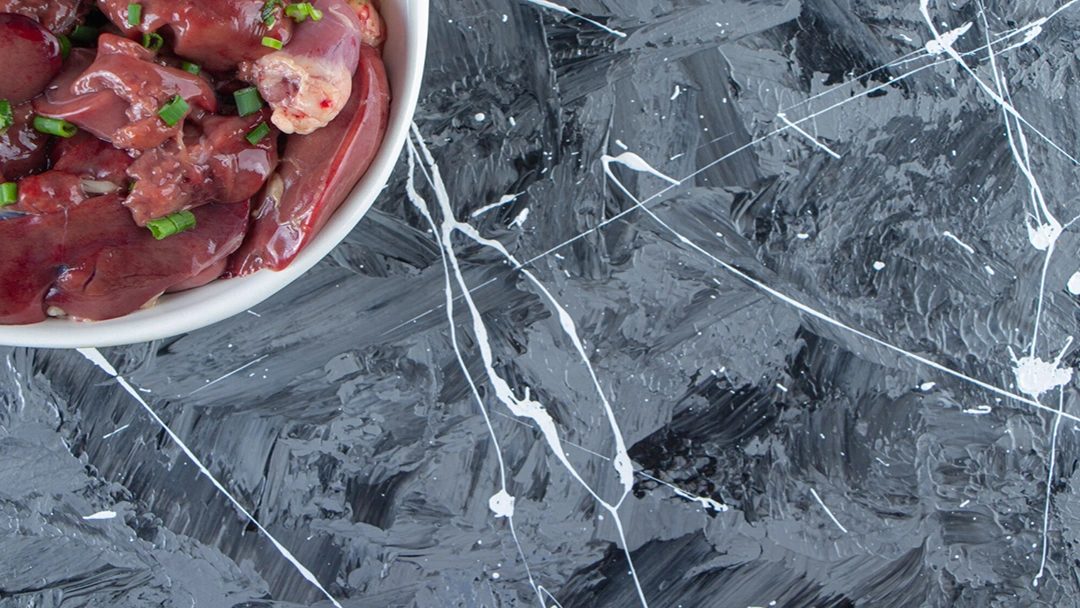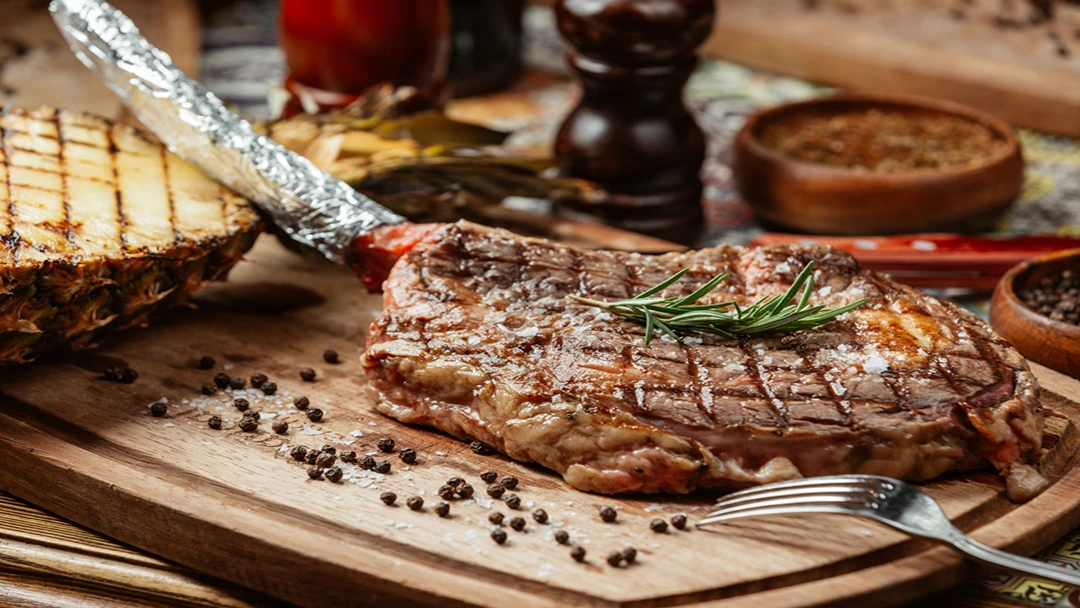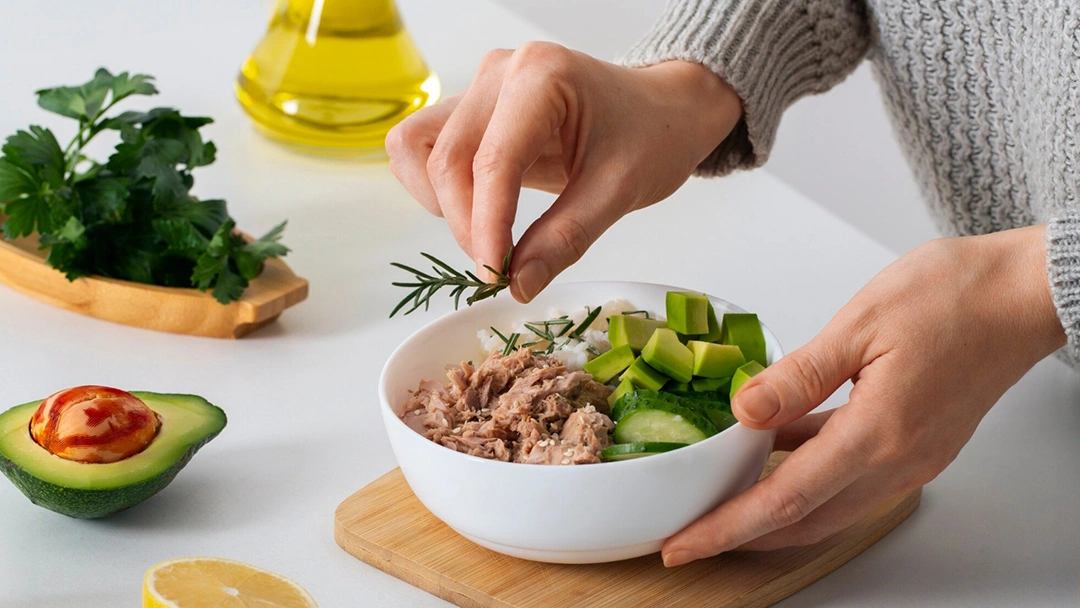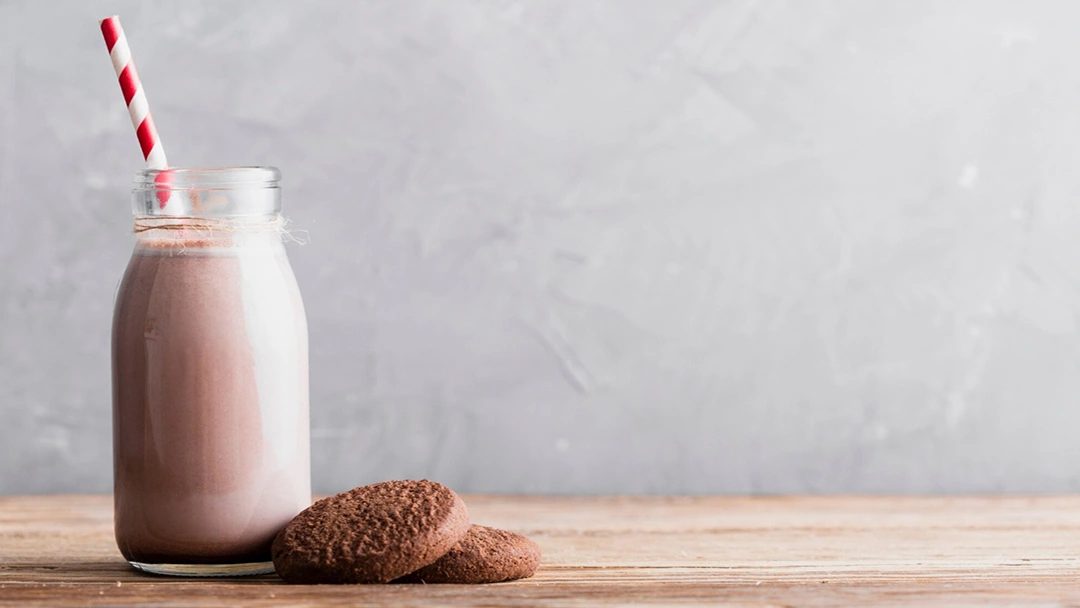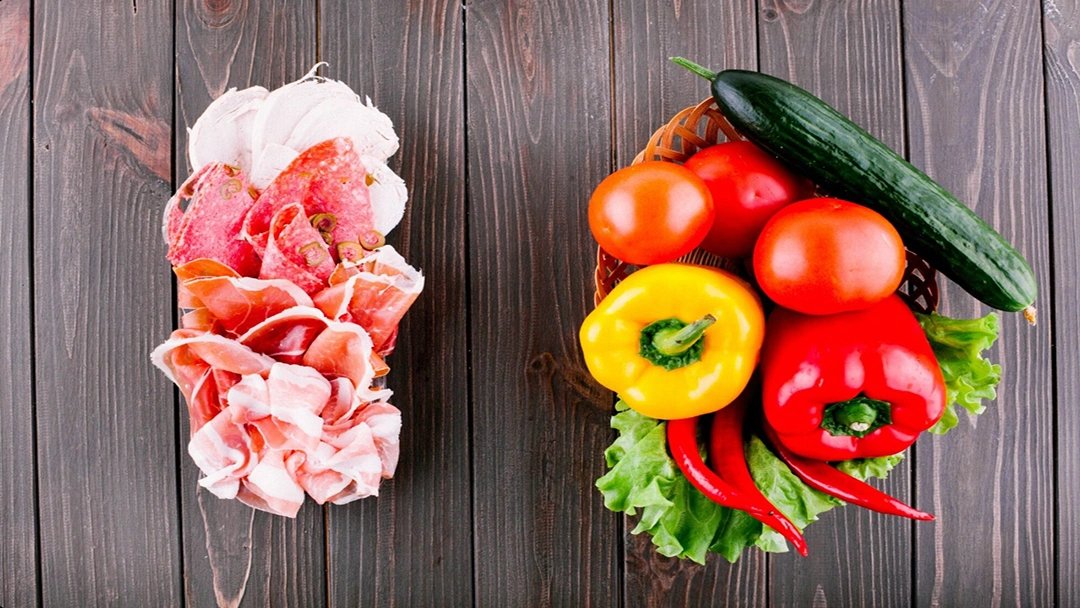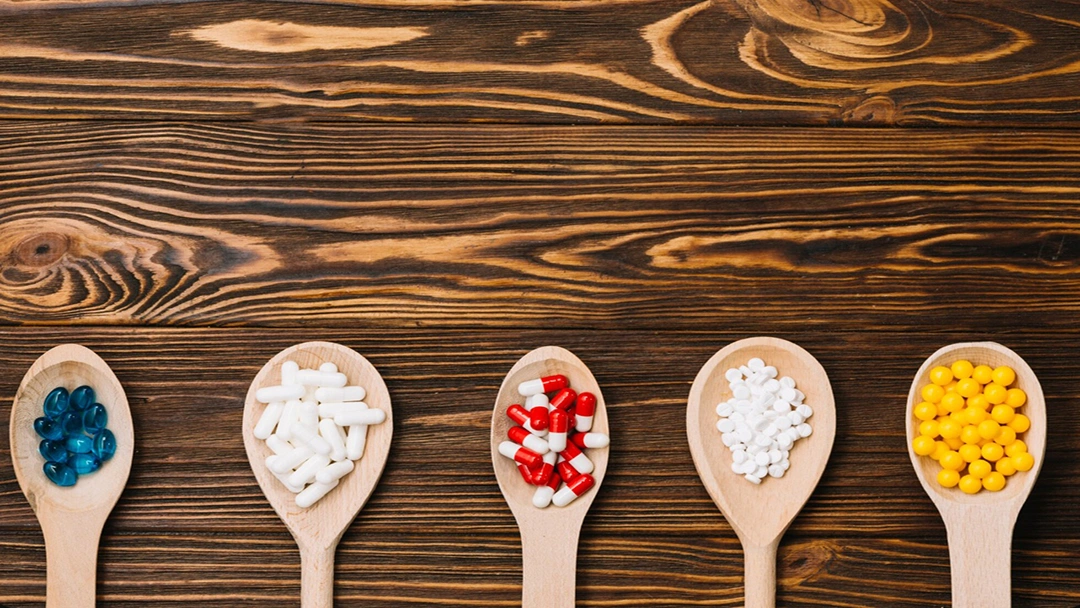Pork
Another delicious Carnivore-friendly source of nutrients is pork, which is a type of meat coming from domestic pigs. Its different cuts can include chops, tenderloin, ribs, and ground pork [3].
100 gram of pork can approximately contain the following nutrients.
- Proteins: 25 g
- Phosphorus: 180 mg
- Niacin (Vitamin B3): 5 mg
- Zinc: 2.5 mg
- Iron: 1 mg
- Vitamin B6: 0.7 mg
- Thiamin (Vitamin B1): 0.6 mg
- Riboflavin (Vitamin B2): 0.2 mg
- Selenium: 30 mg
- Vitamin B12: 0.8 mg
Veal
The delicious meat coming from a young calf is called veal. This kind of meat is also tender in texture and mild in flavour and is used in various cuisines for its taste.
Every 100 grams of cooked veal can contain the following nutrients, but the cooking method and other factors like the cut of meat affect its nutrition.
- Proteins: 26 g
- Phosphorus: 200 mg
- Niacin (Vitamin B3): 4 mg
- Zinc: 2 mg
- Iron: 1.5 mg
- Vitamin B6: 0.3 mg
- Riboflavin (Vitamin B2): 0.2 mg
- Thiamin (Vitamin B1): 0.1 mg
- Selenium: 15 mcg
- Vitamin B12: 2.1 mcg
[cta-gocarnivore-plans]
Learn More: The 10 Best Meat Sticks: How to Eat Them?
"Animal foods are the foundation of the Carnivore Diet. They provide bioavailable nutrients in forms that our bodies have evolved to thrive on."
Goat
Goat meat, aka caprine meat, is meat from domesticated goats. It may sound strange to some cultures and cuisines, but goat meat is favoured in many parts of the world [4].
Goat meat is different from other kinds of meat for its distinct flavour and lean characteristics, and you can make it through various methods, including grilling, roasting, stewing, or currying.
Here is a list of approximate nutrients in 100 grams of cooked goat meat.
- Proteins: 26 g
- Phosphorus: 190 mg
- Niacin (Vitamin B3): 4 mg
- Iron: 3 mg
- Zinc: 2 mg
- Vitamin B6: 0.2 mg
- Riboflavin (Vitamin B2): 0.2 mg
- Thiamin (Vitamin B1): 0.1 mg
- Selenium: 25 mcg
- Vitamin B12: 1.8 mcg
Are you worried about constipation after consuming all this meat? Read about Carnivore Diet Constipation [5 Ways to Fix it].
Elk
Elk meat, aka venison or deer meat, comes from the elk, large deer of North America and Eurasia. Elk meat is also favored by many people around the world, whether looking for a Carnivore diet food list or not, for its lean, flavorful, and slightly gamey taste.
[cta-meetings]
Elk meat is usually more expensive and a kind of specialty meat favored by dieters or individuals enjoying the taste of game meats. The list below shows how many nutrients you can find in 100 grams of cooked Elk.
- Proteins: 22-26 g
- Phosphorus: 200-250 mg
- Niacin (Vitamin B3): 3-4 mg
- Zinc: 3-4 mg
- Iron: 2-4 mg
- Vitamin B6: 0.5-0.7 mg
- Riboflavin (Vitamin B2): 0.2-0.3 mg
- Thiamin (Vitamin B1): 0.1 mg
- Selenium: 15-25 mcg
- Vitamin B12: 1-2 mcg
"The Carnivore Diet has simplified my approach to food. I stick to a few basic animal products, and I feel better than ever."
Antelope
Antelope is a herbivorous mammal in different species, producing lean and tender meat with a distinct flavour. Antelope is considered game meat and is mainly consumed in areas where antelope is common.
100 grams of Antelope can include the following nutrients based on the cooking method and the kind of meat.
- Proteins: 21-26 g
- Phosphorus: 200-250 mg
- Niacin (Vitamin B3): 3-5 mg
- Iron: 2-4 mg
- Zinc: 2-4 mg
- Vitamin B12: 1-3 mg
- Vitamin B6: 0.3-0.7 mg
- Riboflavin (Vitamin B2): 0.2-0.3 mg
- Thiamin (Vitamin B1): 0.1 mg
- Selenium: 15-25 mcg
[cta-meal-plan]
Bison
Bison or American buffalo is a large North American mammal, which is favored for its rich flavour and lean game meat. Bison meat is a nutrient-dense animal product, which is known to be a healthier alternative to beef.
The following list shows the nutrient content of 100 grams of Bison.
- Proteins: 21-23 g
- Phosphorus: 200-250 mg
- Niacin (Vitamin B3): 4-5 mg
- Zinc: 4-5 mg
- Iron: 2-4 mg
- Vitamin B6: 0.4-0.7 mg
- Riboflavin (Vitamin B2): 0.2-0.3 mg
- Thiamin (Vitamin B1): 0.1 mg
- Selenium: 25-30 mcg
- Vitamin B12: 2-3 mcg
Bacon
Bacon is a delicious kind of salt-cured meat made from the cuts of the belly or back of the pig. Bacon is most commonly used for breakfast, but it is also used as a base or part of other meals [5].
Bacon is usually fried or grilled until crispy and is used as an ingredient in various dishes. 100 gram of bacon can contain the following nutrients.
- Proteins: 13-16 g
- Calories: 42-43 cal
- Fat: 40-42 g
- Carbohydrates: less than 1 g
- Sodium: 1,000-1,500 mg
- Cholesterol: 40-50 mg
[cta-gocarnivore-plans]
Learn More: Free 30-Day Carnivore Diet Meal Plan
Dr. Jordan Peterson's Daughter:
"For me, the Carnivore Diet food list is liberating. I know exactly what I can and can't eat, and it makes meal planning effortless."
Carnivore Diet Organ Meat List
Organ meat or offal includes the internal organs and glands of herbivorous animals and some poultry consumed as food. The most commonly used organs are the liver, kidneys, heart, brain, sweetbreads (pancreas), tripe (stomach lining), and some other parts.
Organ meat has a special taste, is rich in nutrients (like vitamins, minerals, proteins, and healthy fats) and is versatile for cooking in different methods. Let’s learn more about the most favored organ meats and check their nutrient content.
Kidney
The kidney is an important organ of animals, but regarding culinary, the kidney is considered an organ meat, which is used in numerous cuisines.
The following list shows the number of nutrients in 100 grams of cooked kidney.
- Protein: 24 g
- Fat: 3 g
- Calories: 112 cal
- Vitamin B12: a lot, over 400% of the Recommended Daily Intake (RDI)
- Vitamin B6: a lot, making about 40% of the RDI
- Vitamin A: about 10% of the RDI
- Iron: around 10% of the RDI
- Riboflavin (Vitamin B2): about 15% of the RDI
- Niacin (Vitamin B3): about 15% of the RDI
- Phosphorus: about 20% of the RDI
- Zinc: about 10% of the RDI
[cta-meetings]
Heart
Heart meat, especially made from beef, pork, or chicken, is used in various cuisines worldwide is consumed in different cuisines worldwide. 100 grams of heart meat can contain the following nutrients.
- Protein: 26 g
- Fat: 6 g
- Calories: 135 cal
- Vitamin B12: a lot, over 200% of the Recommended Daily Intake (RDI)
- Iron: about 20% of the RDI
- Riboflavin (Vitamin B2): about 30% of the RDI
- Niacin (Vitamin B3): around 15% of the RDI
- Vitamin B6: about 10% of the RDI
- Phosphorus: about 20% of the RDI
- Selenium: around 10% of the RDI
- Zinc: about 10% of the RDI
- Copper: around 10% of the RDI
"I've never felt better since I started following the Carnivore Diet. It's amazing how satisfying and nourishing animal foods can be."
Liver
Liver meat, especially made from beef, pork, chicken, or lamb, is part of many dishes around the world in different cultures and cuisines and contains various nutrients. 100 grams of cooked liver meat can contain the following nutrients.
[cta-meal-plan]
- Protein: 27 g
- Fat: 5 g
- Calories: 175 cal
- Vitamin A: a lot, over 500% of the Recommended Daily Intake (RDI)
- Vitamin B12: a lot, about 1,175% of the RDI
- Riboflavin (Vitamin B2): about 150% of the RDI
- Folate (Vitamin B9): around 65% of the RDI
- Niacin (Vitamin B3): about 60% of the RDI
- Vitamin B6: about 30% of the RDI
- Iron: around 30% of the RDI
- Copper: about 15% of the RDI
- Zinc: about 15% of the RDI
- Selenium: around 60% of the RDI
Sweetbread
Sweetbread meat or sweetbreads is the thymus or pancreas glands of young calves, lambs, or pigs cooked for food. Despite its strange name for organ meat, sweetbread is neither sweet nor contains bread!
Sweetbread is one of the most favoured kinds of organ meat for its special taste and nutrient density. 100 grams of cooked sweetbreads can contain the following nutrients.
- Protein: 15-20 g
- Fat: 10-15 g
- Calories: 200-250 cal
- Vitamin B12: over 100% of the Recommended Daily Intake (RDI)
- Riboflavin (Vitamin B2): about 20-30% of the RDI
- Niacin (Vitamin B3): around 10-15% of the RDI
- Iron: about 10-15% of the RDI
- Zinc: about 10% of the RDI
- Selenium: about 10% of the RDI
[cta-gocarnivore-plans]
Brain
Brain meat comprises soft and highly nutritious tissues, which are used in different cuisines in many parts of the world. Every 100 grams of cooked brain meat can contain the following nutrients.
- Protein: 10-12 g
- Fat: 10-12 g
- Calories: 130-140 cal
- Cholesterol: 1,000-2,000 mg
- Vitamin B12: over 100% of the Recommended Daily Intake (RDI)
- Riboflavin (Vitamin B2): about 20-30% of the RDI
- Niacin (Vitamin B3): around 10-15% of the RDI
- Iron: about 10-15% of the RDI
- Phosphorus: about 10-15% of the RDI
- Selenium: around 10-15% of the RDI
- Zinc: about 10% of the RDI
Spleen
Spleen meat, in culinary terms, refers to the edible tissue from the animals’ spleen, which is used in some cuisines, although not so frequently everywhere.
Spleen meat can contain the following nutrients in every 100 grams.
- Protein: 20-22 g
- Fat: 2-3 g
- Calories: 90-100 cal
- Vitamin B12: over 100% of the Recommended Daily Intake (RDI)
- Vitamin B6: about 15-20% of the RDI
- Niacin (Vitamin B3): around 10-15% of the RDI
- Iron: about 10-15% of the RDI
- Zinc: about 10% of the RDI
- Selenium: about 10% of the RDI
[cta-meetings]
Tripe
Tripe is the edible lining of the stomach of cows, sheep, or goats, which has been a part of various traditional cuisines. It has a distinctive texture and flavour and contains various nutrients.
Tripe meat is favoured by many for its relatively low fat and calories and high levels of protein and vitamins (especially vitamin B12 and B2), and minerals (including iron, zinc, and selenium).
Also, tripe is rich in collagen, which is beneficial for skin and tissues. Remember to buy tripe and other organ meats from reliable sources to avoid any health problems.
Let’s check out the following list that shows the nutrients contained in 100 grams of cooked tripe meat.
- Protein: 16-20 g
- Fat: 3-5 g
- Calories: 90-120 cal
- Vitamin B12: over 50% of the Recommended Daily Intake (RDI)
- Vitamin B2: about 15-20% of the RDI
- Niacin (Vitamin B3): around 10-15% of the RDI
- Iron: about 10-15% of the RDI
- Zinc: about 10-15% of the RDI
- Selenium: about 10% of the RDI
Carnivore Diet Poultry List
Domesticated birds raised for their meat, eggs, or feathers are called poultry. The category includes chicken, turkey, and duck. Poultry is commonly used and favored around the globe and is a part of various dishes.
[cta-meal-plan]
Let’s learn more about the three most common kinds of poultry used by Carnivore dieters, i.e., chicken, turkey and duck.
Top Chicken Producing Countries in 2023/2024
According to the statistics of the U.S. Department of Agriculture, the United States, Brazil, China, and the United Nations have been the top chicken producing countries in 2023-2024, with about 21.08 million metric tons, 14.9 million metric tons, 14.8 million metric tons, and 11.06 million metric tons of production, respectively.
Chicken
Versatility, mild flavour, relatively low fat, and high amounts of protein have made chicken a famous culinary option. The protein content of chicken is essential for muscle growth, tissue repair, and general body function.
Also, removing the chicken’s skin makes it a low-fat food, which is best for those looking for low-fat, high-protein dishes.
Also, different parts of the chicken’s body can be used in various dishes. 100 grams of cooked chicken breast can contain the following nutrients.
- Protein: 31 g
- Fat: 3.6 g
- Calories: 165 cal
- Vitamin B3 (Niacin): around 40% of the Recommended Daily Intake (RDI)
- Vitamin B6: about 25% of the RDI
- Vitamin B5 (Pantothenic Acid): around 10% of the RDI
- Vitamin B2 (Riboflavin): about 10% of the RDI
- Vitamin B12: about 5-10% of the RDI
- Iron: around 6% of the RDI
- Zinc: about 5-10% of the RDI
- Phosphorus: about 20% of the RDI
- Selenium: around 20-30% of the RDI
Turkey
Turkey has one of the most high-quality kinds of meat but is considered red meat despite being poultry. In addition to daily usage, turkey is part of festive occasions like Thanksgiving.
[cta-gocarnivore-plans]
Turkey’s distinctive flavour and relatively lean profile make it ideal for various dishes. But those looking for a Carnivore diet food list may see it less commonly in recipes for its lean content.
Having said that, turkey is a base of many Carnivore-friendly dishes, especially for its high protein and low-fat content. Here are the nutrients found in 100 grams of turkey.
- Protein: 29 g
- Fat: 3.6 g
- Calories: 165 cal
- Vitamin B3 (Niacin): almost 45-50% of the Recommended Daily Intake (RDI)
- Vitamin B6: about 20-25% of the RDI
- Vitamin B2 (Riboflavin): about 10-15% of the RDI
- Vitamin B5 (Pantothenic Acid): around 10-15% of the RDI
- Vitamin B12: about 5-10% of the RDI
- Iron: around 4-6% of the RDI
- Zinc: about 5-8% of the RDI
- Phosphorus: about 20% of the RDI
- Selenium: around 25-30% of the RDI
Learn More: Carnivore Bacon, Sliced Turkey and Ham Breakfast Sandwich
Duck
Duck meat is darker, with higher fat content compared to chicken or turkey. It is a widely used ingredient for various Asian and European dishes, especially French cuisine.
The fat in duck consists of both saturated and unsaturated fats, including omega-3 fatty acids, which are beneficial for heart health. While it includes healthy fats and high levels of protein, duck’s higher fat content means it contains more calories as well.
[cta-meetings]
Here are the nutrients contained in 100 grams of cooked duck meat.
- Protein: 20 g
- Fat: 12 g
- Calories: 210-230 cal
- Vitamin B3 (Niacin): around 30-40% of the Recommended Daily Intake (RDI)
- Vitamin B6: about 15-20% of the RDI
- Vitamin B5 (Pantothenic Acid): around 10-15% of the RDI
- Vitamin B2 (Riboflavin): about 10-15% of the RDI
- Vitamin B12: about 5-10% of the RDI
- Iron: around 6-10% of the RDI
- Zinc: almost 5-10% of the RDI
- Phosphorus: about 15-20% of the RDI
- Selenium: around 15-20% of the RDI
Carnivore Diet Seafood List
Seafood is an umbrella term referring to all edible sea animals, from different kinds of fish to lobster, oysters, crabs, etc. Seafood is widely favoured and used for its high levels of nutrients, including high-quality protein, omega-3 fatty acids, vitamins, and minerals.
Let’s get to know the most famous kinds of seafood used by Carnivore dieters and see what kinds o nutrients they contain.
Learn More: Carnivore Diet Seafood Salad with 3 Ingredients
[cta-meal-plan]
Salmon
Salmon is one of the most commonly used kinds of fish in the Carnivore diet recipes for its rich, oily texture and distinctive taste.
Salmon is mainly recommended by healthcare professionals for containing omega-3 fatty acids, especially EPA and DHA, which improve heart health and brain function and reduce inflammation.
Salmon is also rich in protein and provides amino acids necessary for growth and tissue repair. Let’s see what and how many nutrients can be found in 100 grams of cooked Salmon.
- Protein: 20 g
- Fat: 13 g
- Calories: 206 cal
- Omega-3 Fatty Acids: 1.8 grams
- Vitamin B12: about 80-90% of the Recommended Daily Intake (RDI)
- Vitamin D: about 100-150% of the RDI
- Vitamin B3 (Niacin): about 50-70% of the RDI
- Vitamin B6: around 20-30% of the RDI
- Vitamin B5 (Pantothenic Acid): about 10-15% of the RDI
- Vitamin B2 (Riboflavin): about 10-20% of the RDI
- Vitamin B1 (Thiamine): around 10% of the RDI
- Selenium: about 40-60% of the RDI
How Much Fish Will Be Left in 2050?
The Ellen MacArthur Foundation's updated figure for fish in the sea in 2050 is roughly 899 million tonnes. But it also increases its estimate for the amount of plastic in the ocean in 2050 to between 850 million and 950 million tonnes, or about 25% more than originally predicted.
Sardine
Sardines are small, oily fish with various health benefits. That’s why many Carnivore diet food lists always contain sardines. They also contain omega-3 fatty acids, including EPA and DHA.
[cta-gocarnivore-plans]
Let’s take a look at the nutrients found in 100 grams of cooked Sardines and learn how effective they can be for Carnivore dieters.
- Protein: 25 g
- Fat: 11 g
- Omega-3 Fatty Acids: 2 g
- Vitamin B12: about 90-100% of the Recommended Daily Intake (RDI)
- Vitamin D: about 50-70% of the RDI
- Vitamin B3 (Niacin): about 20-30% of the RDI
- Vitamin B2 (Riboflavin): around 20-30% of the RDI
- Vitamin B6: about 10-15% of the RDI
- Calcium: about 10-15% of the RDI
- Phosphorus: around 20-30% of the RDI
- Selenium: about 40-50% of the RDI
Mackerel
Like other kinds of fish loved by Carnivore dieters, Mackerel is oily and full of nutrients, including omega-3 fatty acids, high-quality protein, and various vitamins and minerals.
Make sure to cook Mackerel through to avoid foodborne illnesses. Let’s see what kinds of nutrients can be found in 100 grams of cooked Mackerel.
- Protein: 18 g
- Fat: 13 g
- Calories: 205-230 cal
- Omega-3 Fatty Acids: 1.5-2.5 g
- Vitamin D: about 200-300% of the Recommended Daily Intake (RDI)
- Vitamin B12: about 150-200% of the RDI
- Vitamin B3 (Niacin): about 20-40% of the RDI
- Vitamin B6: almost 10-20% of the RDI
- Vitamin B2 (Riboflavin): about 10-15% of the RDI
- Vitamin E: about 10-20% of the RDI
- Selenium: about 40-60% of the RDI
[cta-meetings]
Tuna
Even those who don’t like seafood like Tuna fish as it is rich in protein and several vitamins and minerals. It also contains high levels of omega-3 fatty acids.
Just remember that larger species of tuna can contain mercury, so it’s better to look for smaller ones, like skipjack tuna.
Choose fresh or frozen tuna and always buy seafood from reliable shops and cook it through to avoid food poisoning and other health issues.
Canned tuna is also a popular and safe source of getting tuna nutrients. So, let’s see how much nutrients we can get by eating 100 grams of cooked tuna fish.
- Protein: 23-25 g
- Fat: 1-5 g
- Calories: 109-144 cal
- Omega-3 Fatty Acids: 0.1-1.1 g
- Vitamin B3 (Niacin): about 50-60% of the Recommended Daily Intake (RDI)
- Vitamin B12: 120-150% of the RDI
- Vitamin B6: 25-30% of the RDI
- Selenium: 60-70% of the RDI
- Phosphorus: 15-20% of the RDI
- Magnesium: 5-10% of the RDI
- Potassium: 5-10% of the RDI
Shrimp
Shrimp is a good ingredient in the Carnivore diet as it is low in calories and high in various nutrients. For example, it is rich in vitamin B12, which helps red blood cell production and nerve function.
Also, shrimp contains high amounts of Selenium, an essential mineral, making shrimp an antioxidant. Other minerals found in shrimp are phosphorus, copper, and zinc, which improve bone health, immune function, and cellular metabolism.
[cta-meal-plan]
Here are the nutritional facts about 100 grams of cooked shrimp.
- Protein: 24 g
- Fat: 0.9 g
- Calories: 100-110 cal
- Omega-3 Fatty Acids: 0.2 g
- Vitamin B12: 40-50% of the Recommended Daily Intake (RDI)
- Selenium: 35-45% of the RDI
- Phosphorus: 10-15% of the RDI
- Choline: 10-15% of the RDI
- Copper: 10-15% of the RDI
- Zinc: 10-15% of the RDI
Learn More: Carnivore Diet Seafood Mix with Cheese and Cream Sauce
Lobster
Lobster is famous for its sweet and tender meat and is popular on special occasions or fine dining. Also, it is rich in proteins, different vitamins, and some omega-3 fatty acids.
The bad news is that lobster has relatively higher cholesterol than other seafood.
Lobster has different species, such as Maine lobster, spiny lobster, or rock lobster, and each one contains specific nutrients and flavour.
The following list shows the nutrients contained in 100 grams of cooked lobster.
- Protein: 20 g
- Fat: 1 g
- Calories: 90-100 cal
- Omega-3 Fatty Acids: 0.2-0.5 g
- Vitamin B12: 50-100% of the Recommended Daily Intake (RDI)
- Copper: 45-65% of the RDI
- Selenium: 35-45% of the RDI
- Zinc: 10-15% of the RDI
- Phosphorus: 10-15% of the RDI
- Magnesium: 5-10% of the RDI
- Iron: 4-8% of the RDI
- Vitamin E: 4-8% of the RDI
[cta-gocarnivore-plans]
Carnivore Diet Fat List
Fat is important for the Carnivore diet as it substitutes carbohydrates and helps the body burn fat for fuel instead of carbs, which results in fat melting and weight loss. It means we fuel the body with fat, not carbs; that’s how we burn fat and lose weight.
It is a concentrated source of energy and provides more calories per gram than carbohydrates and protein. Fat is not just used to fuel the body, but it helps various bodily functions, including the following.
- Energy: Fat provides long-lasting and sustained energy, which is more effective than carbs.
- Nutrient Absorption: Vitamins A, D, E, and K are fat-soluble, i.e., they need dietary fat to be absorbed and used by the body.
- Hormone Production: Fat helps in synthesizing and regulating hormones, such as sex, adrenal, and some metabolic hormones.
- Cell Structure: Cell membranes use fat as a component, as it helps keep the cells integrated and supports cell functions.
- Insulation and Protection: Adipose tissue, which regulates body temperature and creates cushioning to protect organs, is made of fat.
- Satiety: Dietary fat helps you feel full for a longer period, which can help reduce the overall calorie intake.
On a carnivore diet, you can meet your fat needs by consuming fatty cuts of meat, poultry with skin, organ meats, and other animal products containing fat.
The Carnivore diet aims to create a state of ketosis by making dieters consume more fat and protein while minimizing carbohydrate intake to enable the body to rely on fat for energy instead of carbohydrates.
Let’s learn more about the main sources of fat on a Carnivore diet.
Increase your fat-melting results using this free guide: What Is Fat Fasting? Carnivore Method, Meal Plan, and Food List.
[cta-meetings]
Bone Broth
Bone broth is a nutrient-dense liquid made by simmering animal bones and connective tissues in water for about 12 to 24 hours or more.
Bone broth can be used in various ways on a Carnivore diet, including as a base for soups, stews, and sauces or even as a drink. It contains various nutrients, as follows.
- Protein: 6-12 gr per cup
- Minerals: calcium, magnesium, phosphorus, and potassium.
- Gelatin: bone broth is rich in gelatin, which provides amino acids like glycine and proline, which have various health benefits. It’s also good for gut and joint health and may improve skin, hair, and nails.
- Glucosamine and Chondroitin
- Hyaluronic Acid: a compound containing moisturizing and anti-ageing properties.
- Electrolytes: such as sodium and potassium, are found in bone broth. These are necessary for fluid balance, nerve function, and muscle contraction.
Bone Marrow
Animal bones may look empty, but they contain soft, fatty tissue full of nutrients necessary for Carnivore dieters. Bone marrow is also an essential ingredient in blood cell production.
It can be used in cooking in different ways, especially in dishes like bone marrow soups, stews, or as a spread on toast. Some people also use a spoon and consume bone marrow directly from inside roasted bones.
Here are the nutrients generally contained in the bone marrow.
- Healthy Fats: like monounsaturated fats and omega-3 fatty acids, which provide energy and support various bodily functions, such as brain health, hormone production, and cell membrane integrity.
- Proteins: such as collagen and gelatin
- Vitamins and Minerals: vitamin A, K, E, iron, zinc, selenium, and phosphorus
- Bone Marrow-Specific Compounds: it is a source of myeloid and lymphoid stem cells, which are necessary for producing blood cells. It also contains certain immune cells, like macrophages, which are essential in removing infections and supporting immune function.
[cta-meal-plan]
Suet
Suet is a type of hard, white fat from the kidneys of animals like beef or mutton. Having saturated fats and a high melting point makes suet an ideal option for cooking and baking.
Traditional recipes are full of suet, especially those for making pastry crusts, puddings, and some kinds of savory dishes. But remember that it’s usually used for its cooking properties and flavour, not as a standalone food.
Suet can contain the following nutrients.
- Fat: about 95% saturated fat
- Calories: 9 cal. per g
- Vitamin E: small amounts of vitamin E
- Trace Minerals: some amounts of trace minerals, including phosphorus and trace elements like zinc and selenium
Learn More: Suet vs. Tallow: How Do These Dietary Fat Resources Differ?
Butter
Butter is a dairy product coming from churning cream or fermented milk and is a versatile ingredient used in cooking, baking, and as a spread.
Butter is generally low in protein, carbohydrates, and fiber; however, it adds to the flavour and texture of various foods.
Although different kinds of fat contain various nutrients, the following list shows the typical nutrients found in 1 tablespoon (about 14 g) of butter.
- Fat: 11-12 g
- Calories: 100-110 cal.
- Vitamin A: high amounts of vitamin A, mainly as retinol, which is necessary for vision, immune function, and cell growth and differentiation.
- Vitamin D: small amounts of vitamin D, which is crucial for calcium absorption and bone health.
- Vitamin E: trace amounts of vitamin E, which is an antioxidant necessary for protecting cells from damage.
- Cholesterol: 30 mg
Learn More: What Is The Best Butter for The Carnivore Diet? Salted, Unsalted, Ghee or Grass-fed?
[cta-gocarnivore-plans]
Ghee
Ghee is a kind of clarified butter made by simmering butter to remove the milk solids and water, leaving pure butterfat. Having a rich, nutty flavour and a high smoke point, ghee is suitable for cooking, sautéing, and frying.
Each tablespoon of ghee can contain the following nutrients.
- Fat: 14 g
- Calories: 112-120 cal.
- Vitamin A: significant amounts of vitamin A
- Vitamin E: small amounts of vitamin E
- Vitamin K: small amounts of vitamin K
- Short-Chain Fatty Acids: small amounts of short-chain fatty acids, like butyric acid, which are anti-inflammation and improve gut health
Tallow
Tallow is a type of rendered fat from the fatty tissues of animals like beef or mutton. It is a versatile fat used in cooking and baking, with a high melting point.
One tablespoon of tallow can contain the following nutrients.
- Fat: 50-55% saturated fat, 40-45% monounsaturated fat, and small amounts of polyunsaturated fat
- Calories: 115-120 cal.
- Vitamin E: small amounts of vitamin E
- Trace Minerals: trace amounts of phosphorus, selenium, and zinc
[cta-meetings]
Lard
Lard is another kind of rendered fat coming from the fatty tissues of pigs. It has a high smoke point, adds flavour and texture to various dishes, and contains the following ingredients.
- Fat: 39-45% saturated fat, 45-50% monounsaturated fat (including oleic acid), and small amounts of polyunsaturated fat
- Calories: 115-120 calories per tablespoon.
- Vitamin D: significant amounts of vitamin D
- Cholesterol: 10-15 milligrams per tablespoon
- Trace Minerals: small amounts of trace minerals like phosphorus, iron, zinc, and selenium.
Duck fat
Duck fat is the fat rendered from the fatty tissues of ducks, which has a rich flavour and unique features and is primarily used in French cuisine. Here are the nutrients found in duck fat.
- Fat: 33-37% saturated fat, 45-50% monounsaturated fat (including oleic acid), and a small amount of polyunsaturated fat
- Calories: 120-130 calories per tablespoon
- Vitamin E: small amounts of vitamin E
- Cholesterol: 10-15 milligrams per tablespoon
- Trace Minerals: trace amounts of minerals like phosphorus, iron, zinc, and selenium
[cta-meal-plan]
Carnivore Diet Dairy List
Dairy is generally avoided or limited on the Carnivore diet. The limited version allows for hard cheeses like cheddar, heavy cream, and creme fraiche.
Those Carnivore dieters consuming limited amounts of dairy products do so because of the following features of them.
- Nutrient Density: Dairy products contain high levels of protein, calcium, phosphorus, vitamin B12, and vitamin D.
- Versatility and Taste
Let’s learn more about the main dairy products allowed on a Carnivore diet.
Learn More: Can You Eat Cheese on The Carnivore Diet? What Is The Best Cheese?
Hard Cheese
Different kinds of hard cheese are allowed and commonly consumed on a Carnivore diet, including the following, which come with various nutrients.
- Cheddar Cheese: a popular hard cheese containing high levels of protein, calcium, phosphorus, vitamin A, and vitamin B12. On average, cheddar cheese contains 400-410 cal. per 100 g, with about 25 g of protein, 33 g of fat, and 1.3 g of carbohydrates.
- Parmesan Cheese: a hard, aged cheese with a nutty flavour, which is mainly grated and used as a topping or ingredient in different dishes. Parmesan is rich in protein, calcium, phosphorus, and vitamin A. Also, having relatively low levels of lactose makes it ideal for people with lactose intolerance. Parmesan cheese provides about 420-450 cal. per 100 g, with about 35-40 g of protein, 28-30 g of fat, and 3-4 g of carbohydrates.
- Gouda Cheese: a semi-hard to hard cheese with a creamy texture and a mild, slightly sweet taste. Gouda is rich in protein, calcium, phosphorus, vitamin K2, and vitamin B12. Gouda cheese provides about 350-380 cal. per 100 g, with about 25-30 g of protein, 26-30 g of fat, and 2-3 g of carbohydrates.
- Swiss Cheese: Swiss cheese, aka Emmental, is famous for holes or eyes. It contains high amounts of protein, calcium, phosphorus, and vitamin B12. Swiss cheese provides about 380-410 cal. per 100 g, with about 26-30 g of protein, 28-30 g of fat, and 4-5 g of carbohydrates.
[cta-gocarnivore-plans]
Heavy Cream/ Whipping Cream
Heavy or whipping cream is a high-fat dairy product that is whipped to incorporate air, resulting in a light and fluffy texture. Here are the nutrients contained in whipping cream.
- Fat: 36-40%
- Calories: 400-450 calories per 100 grams
- Vitamin A: moderate amounts of vitamin A
- Trace Minerals: small amounts of trace minerals like calcium, phosphorus, potassium, and magnesium
- Carbohydrates and Protein: minimal amounts of carbohydrates and protein
Learn More: Carnivore Diet Heavy Whipped Cream
Crème Fraîche
Crème fraîche is a rich and creamy French-style cream with a tangy flavour made by fermenting heavy cream with a bacterial culture, which has a high fat content.
Crème fraîche contains the following nutrients.
- Fat: 30% to 40%
- Calories: 300-400 calories per 100 grams
- Protein: 1-2 grams per 100 grams
- Carbohydrates: minimal carbohydrates, about less than 2 grams per 100 grams
- Calcium: good amounts of calcium
[cta-meetings]
Carnivore Diet Drink List
Water is the main beverage allowed on the Carnivore diet, but sometimes coffee is also accepted, especially when combined with butter. Let’s learn more about these two beverages on a Carnivore diet food list.
Learn More: Alcohol on Carnivore diet
Water
Water is literally the beverage of life and an essential component of our bodies, with various functions in overall health. Water does not have high amounts of macronutrients like proteins, carbohydrates, or fats, but it is necessary for hydration and physiological processes.
Let’s check out the main benefits of water on a Carnivore diet to see why Carnivore dieters need to drink plenty of water daily.
- Hydration: Drinking enough water and staying hydrated keeps the fluid balance, improves digestion, and transports nutrients. Adequate hydration is of utmost importance on the Carnivore diet, as the dieters can’t consume water-rich foods like fruits and vegetables.
- Thermoregulation: Water is a key player in regulating body temperature using sweating and evaporation.
- Nutrient Absorption: The absorption of water-soluble vitamins and minerals and digestion of nutrients are done properly, thanks to water.
- Detoxification: Water is essential for flushing out toxins and unwanted products from the body. It helps kidneys filter waste and toxins from the blood and excrete them through urine.
- Joint Lubrication: Water is an integral part of synovial fluid, which lubricates joints, removes stiffness, and reduces friction in movement.
Coffee
Coffee is one of the most commonly used drinks by some Carnivore dieters despite being a plant-based product. Coffee lacks essential nutrients like proteins, carbohydrates, or fats, but it contains compounds with potential health benefits.
[cta-meal-plan]
The following list shows coffee's components and its potential benefits for those following a Carnivore diet.
- Caffeine: Coffee is full of caffeine, a natural stimulant, which can temporarily boost energy and improve concentration. It improves the central nervous system, cognitive function, reaction time, and exercise performance.
- Antioxidants: Coffee is a good source of antioxidants like chlorogenic acids and polyphenols, which reduce oxidative stress and inflammation. Antioxidants include other health benefits, such as fighting chronic diseases like cardiovascular disease and some types of cancer.
- Hydration: While coffee increases urine production, it helps overall fluid intake and can boost hydration. But you need to drink caffeinated beverages in moderation as they can cause increased fluid loss and affect hydration.
- Mental Well-being: Consuming moderate amounts of caffeine from coffee helps reduce the risk of depression and lowers the possibility of some neurological conditions like Parkinson's disease and Alzheimer's disease.
Other
Here are some other necessary foods allowed on a Carnivore diet food list which couldn’t be categoriszed under previous categories.
Salt
Salt is a mineral most commonly used to spice up and add flavour to foods. Salt does not contain a lot of macronutrients like proteins, carbohydrates, or fats, but it is rich in essential minerals, primarily sodium.
Let’s take a closer look at the nutrient content of salt.
- Sodium: Sodium in salt is necessary for balancing body fluids, transmitting nerve impulses, and supporting muscle function. It’s no secret that too much sodium has adverse health effects like hypertension, cardiovascular disease, and kidney problems.
- Chloride: Another important electrolyte found in salt is chloride, which supports fluid balance, regulates pH levels and helps digestion.
[cta-gocarnivore-plans]
Pork Rinds
Pork rinds, aka pork skins or cracklings, are a popular snack and a useful ingredient of many Carnivore diet dishes made from pig skin. They fry or roast the pig skin until it’s crispy and puffy.
Pork rinds are a substitute for different ingredients in Carnivore diet recipes and contain various nutrients as follows.
- Protein: 7-9 g of protein per ounce (28 grams)
- Fat: 5-6 g
- Micronutrients: small amounts of iron, zinc, and B vitamins such as niacin and vitamin B12
- Sodium: 300-500 mg
Vegetables and Fruits List
If you’re looking for vegetables in a Carnivore diet food list, you need to learn more about this diet here at What Is The Carnivore Diet? Myth vs Fact. Because the Carnivore diet does not allow vegetables and generally plant-based foods.
Some people ask if they can eat fruits on a Carnivore diet. The answer is no! The carnivore diet is based on animal products and avoids plant-based foods, including fruits, vegetables, seeds, beans, legumes, etc.
Learn More: What Is The Meat and Fruit Diet? Can I Eat Fruit on A Carnivore Diet?
[cta-meetings]
Summary
Congrats! If you’re reading this, it means you’ve read through this article in the Carnivore diet food list, and now you have a good knowledge of what you are allowed to eat on a Carnivore diet.
This ultimate Carnivore diet food list can be a game-changer for those who are confused about what to eat on this diet and are searching for a simplified, meat-focused approach to nutrition.
From the rich omega-3s in salmon to the iron-packed goodness of beef liver, each food on this list comes with special health benefits necessary for a balanced diet.
If you care about your health and fitness and are looking for a way to boost them both, check out these Carnivore diet courses to streamline your fat-melting process!













